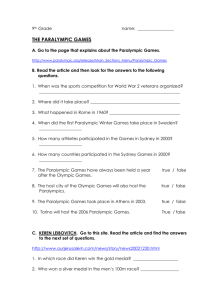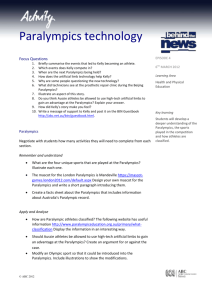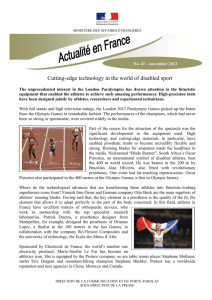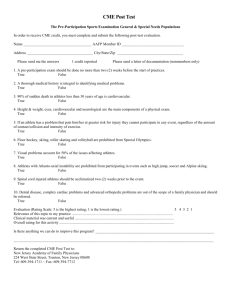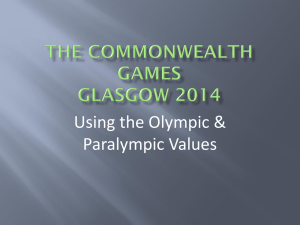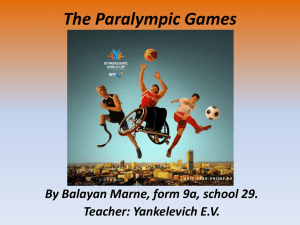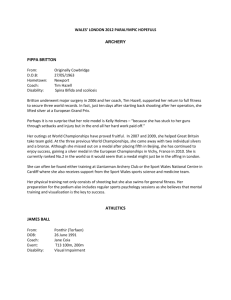Spirit in motion
advertisement
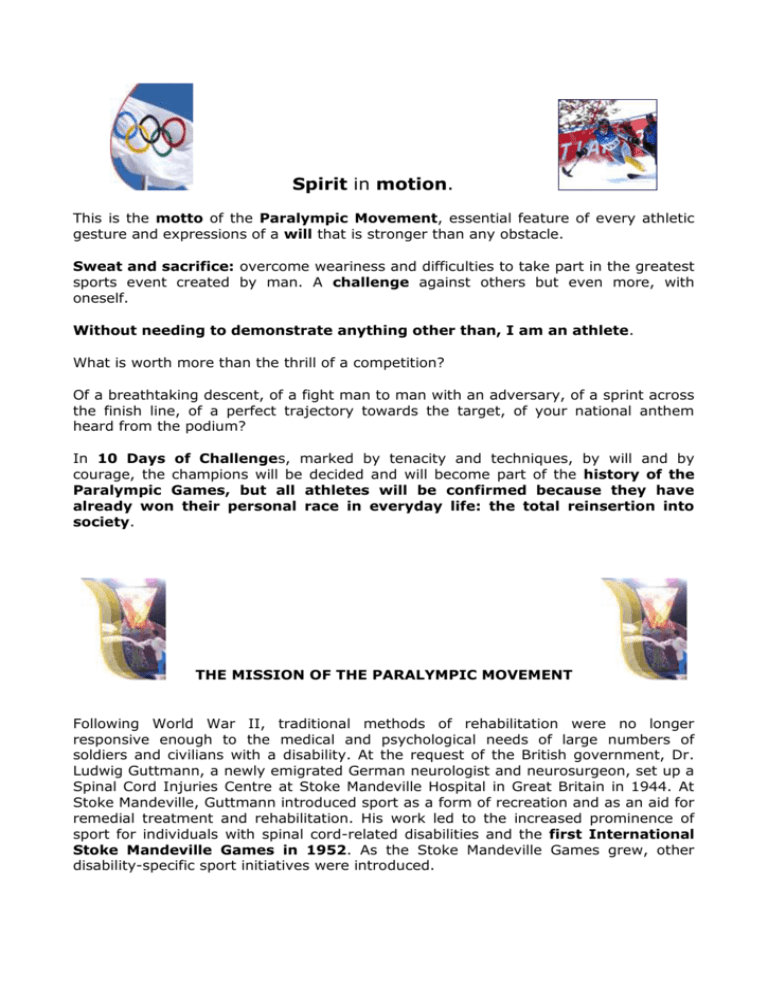
Spirit in motion. This is the motto of the Paralympic Movement, essential feature of every athletic gesture and expressions of a will that is stronger than any obstacle. Sweat and sacrifice: overcome weariness and difficulties to take part in the greatest sports event created by man. A challenge against others but even more, with oneself. Without needing to demonstrate anything other than, I am an athlete. What is worth more than the thrill of a competition? Of a breathtaking descent, of a fight man to man with an adversary, of a sprint across the finish line, of a perfect trajectory towards the target, of your national anthem heard from the podium? In 10 Days of Challenges, marked by tenacity and techniques, by will and by courage, the champions will be decided and will become part of the history of the Paralympic Games, but all athletes will be confirmed because they have already won their personal race in everyday life: the total reinsertion into society. THE MISSION OF THE PARALYMPIC MOVEMENT Following World War II, traditional methods of rehabilitation were no longer responsive enough to the medical and psychological needs of large numbers of soldiers and civilians with a disability. At the request of the British government, Dr. Ludwig Guttmann, a newly emigrated German neurologist and neurosurgeon, set up a Spinal Cord Injuries Centre at Stoke Mandeville Hospital in Great Britain in 1944. At Stoke Mandeville, Guttmann introduced sport as a form of recreation and as an aid for remedial treatment and rehabilitation. His work led to the increased prominence of sport for individuals with spinal cord-related disabilities and the first International Stoke Mandeville Games in 1952. As the Stoke Mandeville Games grew, other disability-specific sport initiatives were introduced. In time, multi-disability competitions developed to become the Paralympic Games the first being held in 1960 in Rome and the first Paralympic Winter Games in 1976. In 1982, the International Coordinating Committee of World Sports Organizations for the Disabled (ICC) was established to govern the Paralympic Games and to represent the participating organizations in dialogues with the International Olympic Committee (IOC) and other global organizations. The word “Paralympic” derives from the Greek preposition “para” (“beside” or “alongside”) and the word “Olympics” (the Paralympics being the parallel Games to the Olympics). “Paralympics” has been the official term of the Games since 1988. The Paralympic Movement's growth is best exemplified through the phenomenal rise of the Paralympic Games. More than 4,000 athletes from 123 nations competed at the Sydney 2000 Paralympics. On 22 September 1989, a new governing body—the International Paralympic Committee (IPC)—was established, as it was the goal to create an international representative organization, with democratically elected representatives, of elite sports for athletes with a disability. The IPC officially replaced the ICC following the 1992 Paralympics in Barcelona. Today, the IPC incorporates around 155 member nations, represented through their National Paralympic Committees (NPCs), and five disability-specific organizations (IOSDs): CP-ISRA, IBSA, INAS-FID, ISMWSF and ISOD. In 1999 the IPC opened its permanent Headquarters in Bonn, Germany, run by professional staff. The IPC is currently composed of the General Assembly (its highest decision-making body), the Executive Committee, the Management Committee, the Headquarters and the various Standing Committees and Commissions. In November 2003, culminating several years of hard work and planning, the IPC took important steps toward a new future when the General Assembly adopted new structures with respect to Governance and Management following a Strategic Review that was conducted in the preceding years. A motion also passed that will lead the 13 IPC sports towards more self-sustainability and eventually independence from the IPC. In addition to the NPCs and IOSDs, also the sports and regional bodies will become full members of the IPC. Paralympic Winter Games Winter sports for athletes with a disability gradually developed after World War II, as large numbers of injured soldiers and civilians tried to return to their skiing activities. Early pioneers such as double-leg amputee Sepp Zwicknagl from Austria experimented with skiing using prostheses. Other innovations were seen in ski equipment design, for instance, three-track skiing using crutches. Three-track skiing is skiing on one leg on one ski using two crutches that have small skis mounted, making three tracks in the snow. This innovation led to the first course in three-track skiing in February 1948, with 17 participants from all over Austria. The event proved popular, and the first Austrian Championships for three-track skiing were held in the following year in Badgastein, Austria. It was in the 1970s that multi-disability skiing competitions started. In 1974, the first world championships were held in Grand Bornand in France, which featured Alpine (Downhill) and Nordic (Cross-Country) Skiing for amputee and visually impaired athletes. The first Paralympic Winter Games were held in 1976 in Örnsköldsvik, Sweden. There were competitions in Alpine and Nordic Skiing for amputee and visually impaired athletes, and a demonstration event in Sledge Racing. The success of the first Games led to the second Winter Paralympics in 1980 in Geilo, Norway. The 1984 Paralympic Winter Games were held in Innsbruck, Austria. For the first time, an exhibition event was held at the Olympic Winter Games in Sarajevo and 30 male three-track skiers took part in the Giant Slalom event. The 1988 Winter Paralympics were again held in Innsbruck, Austria. The Paralympics was not held at the same Olympic venue in Calgary, Canada, because of financial and recruiting difficulties. A total of 397 athletes from 22 countries took part. Sit-Skiing was introduced as another event in both the Alpine and Nordic competitions. The 1992 Games were held in Tignes-Albertville in France. For the first time, there were demonstration events in Alpine and Cross-Country Skiing for athletes with intellectual disabilities. Lillehammer 1994 marked the debut of Ice Sledge Hockey, the Paralympic version of ice hockey that quickly became a crowd-drawer. The 1998 Games in Nagano, Japan, was the first Winter Paralympics to be held outside Europe, and helped to enhance the integration of athletes with a disability and to deepen international recognition. The Nagano Games clearly demonstrated rising media and public interest in Paralympic winter sport.
